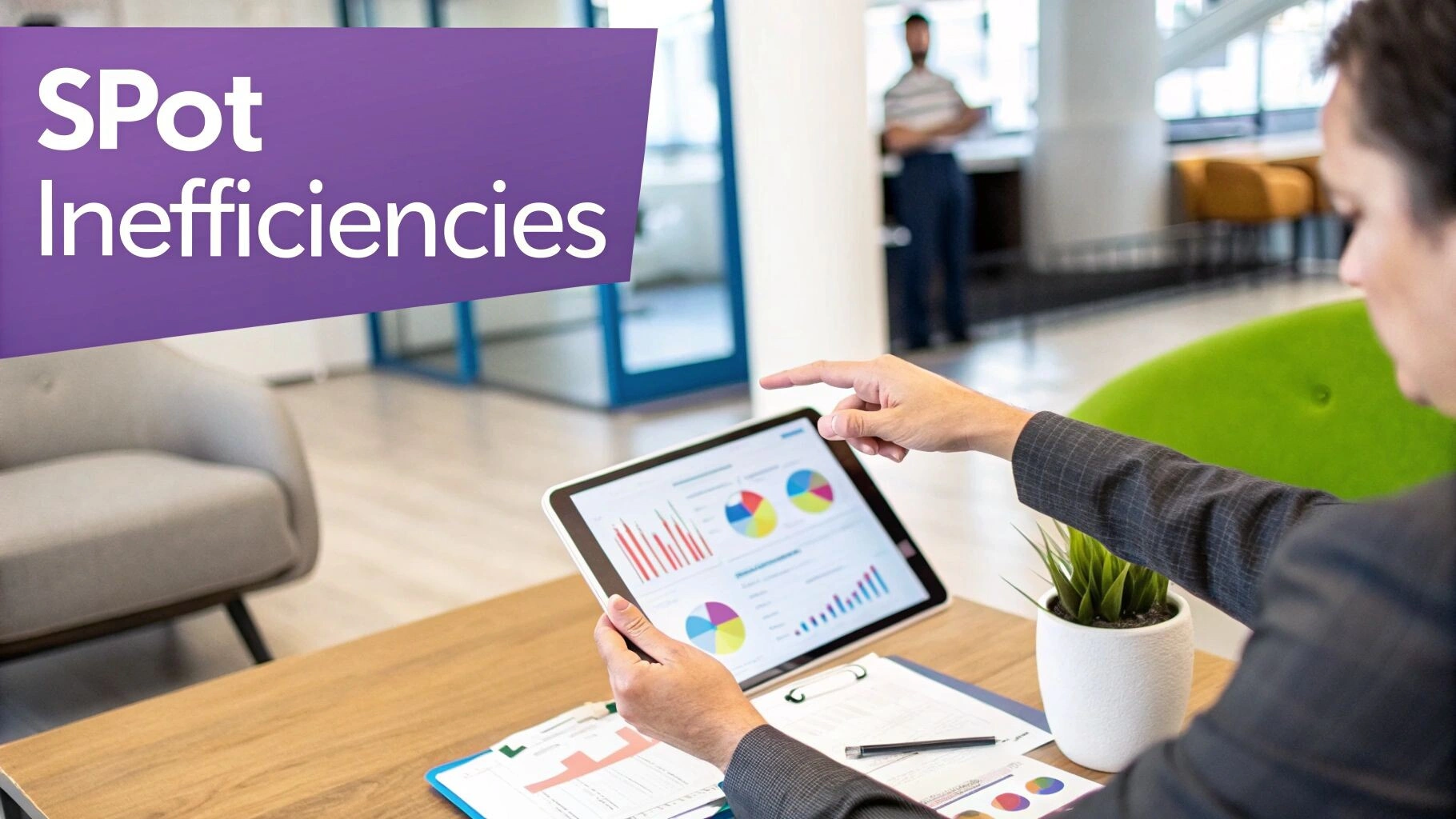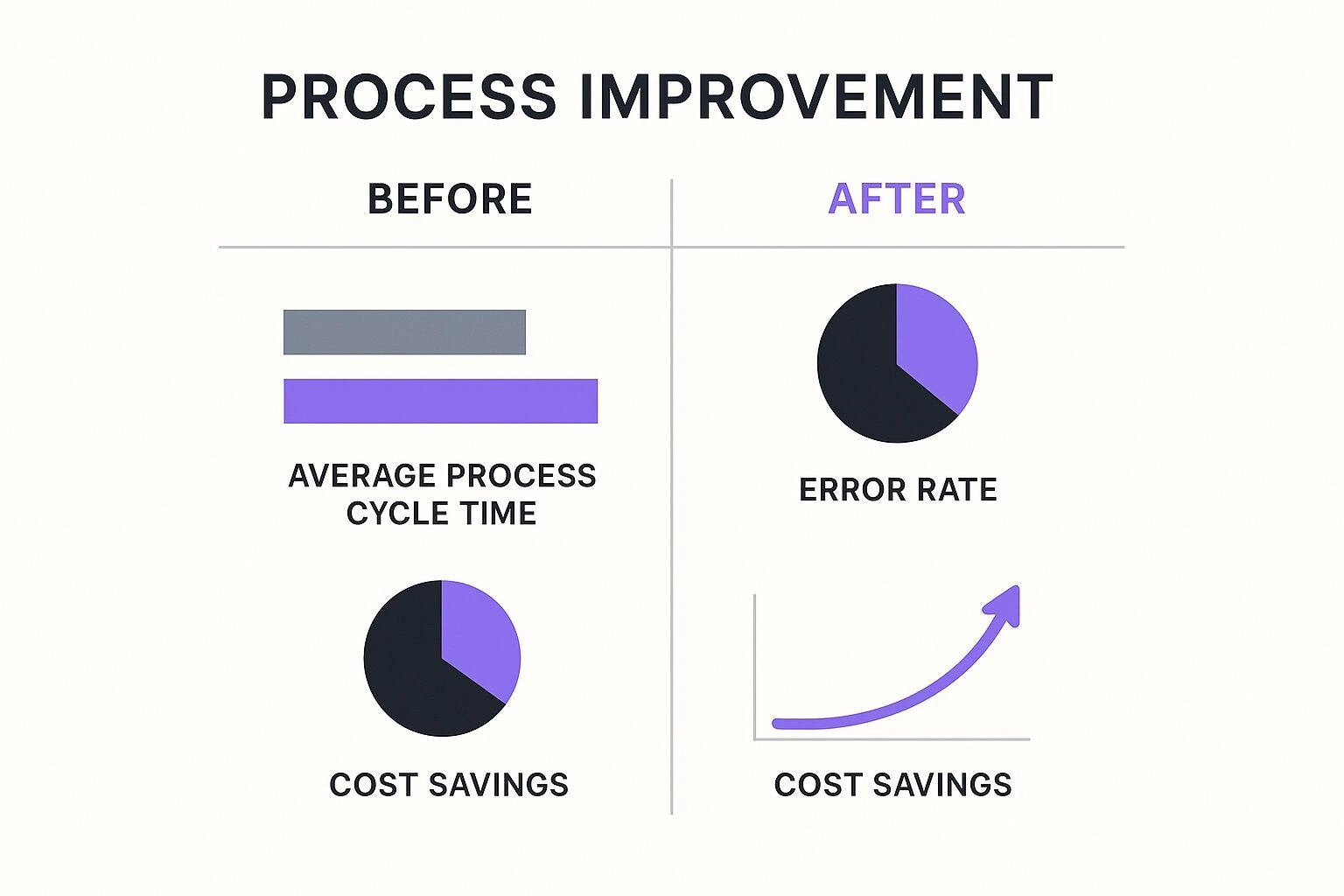Business Process Improvement Tips to Transform Your Operations
Discover the critical factors that determine successful business process improvement, from stakeholder engagement and data-driven decisions to smart tech choices and sustainable change.

Understanding What Actually Drives Business Process Success
Success in Business Process Improvement (BPI) isn’t simply about adopting new software or redesigning flowcharts. It’s about understanding the core drivers that truly revolutionize operations. This involves analyzing why some Australian organizations thrive during process changes, while others struggle.It also means recognizing the critical early decisions that pave the way for success.
The Importance of Early Decisions and Stakeholder Dynamics
One crucial element is early and effective stakeholder engagement. Involving key personnel from the beginning ensures buy-in and minimizes resistance later.This collaborative approach fosters a sense of ownership and guarantees that the improved processes align with the practical realities of day-to-day operations.You might be interested in: How to master business process improvement and streamline your operations.
Additionally, successful BPI initiatives often prioritize solving the right problems. Understanding the underlying models is essential. For instance, exploring various problem-solving models helps ensure your team addresses the root causes of inefficiencies, not just superficial symptoms. This analytical approach establishes a foundation for long-term success.
The Power of Data and Market Trends
Data-driven decision-making is another vital factor. By establishing clear metrics and monitoring progress, organizations can objectively assess the impact of their improvements. This allows for adjustments and refinements throughout the process, ensuring the initiative stays on course and delivers tangible results.
This fact is reflected in the growth of the Australian market. By 2033, the business process management market is projected to reach USD 982.4 million, reflecting a CAGR of approximately 8.58% between 2025 and 2033.This growth highlights the increasing importance of process improvement across Australian businesses. Find more detailed statistics here.
However, technology alone isn’t a guaranteed solution.The most successful initiatives focus on people and processes first, then select technology that supports those improved workflows.This ensures that the technology serves the business needs, not the other way around.This strategic integration maximizes the return on investment and minimizes disruption. Ultimately, understanding these key drivers sets the stage for a successful and sustainable BPI journey.
Creating Your Strategic Improvement Roadmap That Works

Building a successful business process improvement strategy requires a well-defined plan.This strategic roadmap guides your organization toward lasting, impactful change. It begins with understanding your current processes and envisioning your desired future state.Then, you can bridge the gap between the two.
Conducting Meaningful Process Audits
Creating a roadmap starts with a comprehensive process audit. This goes beyond simply identifying flaws.A process audit requires a deep analysis of workflows.The goal is to uncover hidden bottlenecks and opportunities for optimization. Effective audits involve mapping each process step, identifying key stakeholders, and gathering data on performance metrics. This provides a clear picture of your current operations.
Mapping Workflows and Exposing Bottlenecks
After understanding your current processes, visualise them.Tools range from simple flowcharts to sophisticated process mapping software like Microsoft Visio. Visualising workflows helps pinpoint bottlenecks — points where processes slow down or stall.Examples include manual data entry or multi-layered approval processes.
Prioritizing Improvements Based on Real Impact
Not every improvement yields the same results. Some will have a greater impact on your bottom line.Prioritize based on potential impact, not ease of implementation.This ensures focused efforts where they matter most. It might mean tackling a complex, time-consuming process, even if it requires substantial resources.
Engaging Stakeholders and Managing Resistance
Change is often met with resistance, even beneficial changes. Early and frequent stakeholder engagement is critical.Communicate the benefits, address concerns, and provide training and support.Building buy-in and fostering a culture of continuous improvement ensures successful and sustainable business process improvement initiatives. This collaborative approach facilitates smooth transitions and increases the likelihood of long-term success.The Australian business process management (BPM) market is expected to grow at a CAGR of 22.7% from 2025 to 2030. This growth reflects the increasing emphasis on process optimization and automation in Australia.Learn more here.Also, consider the benefits of automation outlined in this article: How to unlock the top business process automation benefits.
Smart Technology Choices That Transform Operations

Beyond the hype, some technologies genuinely transform business process improvement. This section explores the platforms and tools Australian operations teams use to streamline workflows, reduce errors, and gain actionable insights.We’ll focus on selecting solutions based on your specific needs, not just vendor promises.
Evaluating Solutions and Avoiding Pitfalls
Many companies achieve significant improvements with relatively simple tools. Others struggle, even with substantial investments.The key is aligning technology with well-defined processes. For example, implementing a robust Customer Relationship Management (CRM) system like Salesforce before optimizing your sales process may not yield the desired results.
Consider factors like ease of integration with current systems and user adoption rates.A complex platform with a steep learning curve can hinder progress. Focus on solutions that empower your team, not those that add complexity. This approach ensures technology enables your improved processes.
The Rise of BPaaS and Technology-Driven Solutions
Australian businesses are increasingly adopting technology-driven process improvement solutions. This is evident in the expanding Business Process as a Service (BPaaS) market, projected to reach US$2.3 billion in revenue by 2025.Learn more about the BPaaS market here.
This trend highlights the growing reliance on outsourced, tech-driven solutions for optimizing operations. BPaaS offerings often include automation tools, process management platforms, and data analytics capabilities, helping businesses streamline operations, reduce costs, and boost efficiency.
Managing Integration Challenges and Ensuring Team Adoption
Integrating new technology can be complex. Prioritising solutions that emphasise interoperability and seamless integration with legacy systems eases this transition. Change management is also crucial for ensuring adoption.
Providing adequate training and support minimizes resistance and empowers your team to use new tools effectively. This collaborative approach helps ensure your technology investment delivers tangible results.
Practical Guidance and Future-Proofing Your Operations
Successful business process improvement involves choosing technologies that meet both current and future needs.Consider scalability, flexibility, and the potential for future integration with emerging technologies.
This forward-thinking approach helps future-proof your operations and ensures long-term success, positioning your organization for continued growth and optimization in the dynamic business environment.
Implementation Strategies That Actually Stick
Successful business process improvement relies heavily on effective implementation.Designing a new process is only the first step.Putting that process into action effectively requires minimizing disruptions, encouraging adoption, and learning from other organizations’ successes.
Structuring Pilot Programs and Managing Rollouts
Pilot programs are essential for testing and refining new processes before a full launch.These smaller-scale implementations provide valuable insights, allowing you to identify potential issues and adapt your strategy. This iterative approach reduces risk and increases the likelihood of a successful company-wide implementation.
A well-managed rollout is also critical.Maintaining operational continuity is paramount, ensuring daily operations remain smooth during the transition.This might involve phased rollouts, departmental pilot programs, or running old and new processes concurrently until the new system is fully functional.
Addressing Resistance to Change
Change is often met with resistance.Proactively addressing this resistance is crucial for successful business process improvement.Clear and consistent communication about the benefits of the changes, addressing employee concerns, and providing sufficient training and support are key.Engaging stakeholders throughout the process is essential.
Effective Techniques for Timeline Management and Resource Allocation
Effective timeline and resource management are essential for success.Realistic timelines, clearly defined milestones, and regular progress reviews help keep the implementation on track.Strategic resource allocation, including adequate staffing, budget, and technology, is vital.
Consider the long-term costs and benefits of any investments. Choosing the right technology can significantly boost efficiency. Resources like this article on operational efficiency in banking offer practical strategies for using technology to improve operations.
Frameworks for Change Management and Training Strategies
Implementing effective change management frameworks offers structure and guidance during the transition. These frameworks provide established methods for managing change, promoting a smooth implementation. Combined with practical training strategies, they empower your team to adopt new processes and tools, fostering long-term success.
Continuous monitoring and evaluation are essential for identifying potential problems early and making necessary adjustments.This proactive approach ensures your business process improvement efforts remain on course and deliver sustainable results.
Measuring Progress Beyond Basic Metrics

Effective business process improvement (BPI) requires a more nuanced approach than simply tracking basic metrics. It calls for a system that captures both immediate gains and the long-term impact of your improvements.This means shifting focus from measuring mere activity to analyzing indicators that truly predict success. This section explores how leading Australian organizations achieve this.
Establishing Baseline Measurements and Setting Realistic Targets
The foundation of any successful BPI initiative is a solid baseline. This begins with identifying the key performance indicators (KPIs) that are most relevant to your specific business goals.For instance, instead of simply tracking the number of customer service calls, consider measuring the first-call resolution rate. This metric offers a much more insightful view of customer service effectiveness.
Once a baseline is established, it’s crucial to set achievable targets.These targets should be challenging yet realistic, motivating your team without being overwhelming.A 10% improvement in a key metric within the first quarter could be a reasonable starting point. This approach fosters a culture of continuous improvement with attainable milestones.
Building Reporting Systems and Leveraging Data Analytics
Effective reporting systems are essential for translating data into actionable insights. These systems should provide real-time data visibility, enabling quick identification of areas for optimization.This empowers your team to make informed decisions and adapt swiftly to changing circumstances.
Data analytics tools like Tableau play a vital role in this process. Analyzing data trends can reveal hidden opportunities and inform strategic decisions about future process improvements. This ensures that BPI efforts are aligned with overall business objectives.
To better understand the essential metrics and benchmarks for measuring BPI success, let’s examine the following table:
Key Performance Indicators for Process Improvement
Essential metrics and benchmarks for measuring process improvement success across different business functions.
| KPI Category | Primary Metrics | Target Improvement | Measurement Frequency |
|---|---|---|---|
| Customer Service | First-call resolution rate | 10% | Monthly |
| Order Fulfillment | Order processing time | 15% | Weekly |
| Manufacturing | Defect rate | 5% | Daily |
| Sales | Lead conversion rate | 20% | Quarterly |
This table provides a concise overview of how different departments can use KPIs to track and improve their performance. From customer service to sales, focusing on the right metrics allows for targeted improvements and better overall results.
Practical Examples of Successful Measurement Frameworks
Many successful organizations use data analytics to identify emerging opportunities and inform future improvements. For instance, a company might analyze customer feedback data from surveys or platforms like SurveyMonkey to identify recurring pain points in their onboarding process.This data-driven approach enables them to target specific areas for improvement, maximizing the impact of their efforts.
Another example is leveraging data analytics to quantify the efficiency gains from automation initiatives. By measuring metrics such as processing time and error rates before and after implementing automation, companies can showcase the tangible value of their BPI efforts. This provides concrete evidence of the return on investment and justifies further investment in process optimization.
By focusing on meaningful metrics, setting realistic targets, and leveraging the power of data analytics, organizations can establish measurement frameworks that drive long-term success.This approach not only ensures continuous optimization but also cultivates a competitive advantage in the dynamic Australian market.
Avoiding The Traps That Derail Most Initiatives

The infographic above illustrates the positive impact of business process improvement on key performance metrics.Across three areas – average process cycle time, error rate, and cost savings – the benefits are clear. Effective initiatives can significantly reduce cycle times and errors, while also boosting cost savings. For Australian businesses, this means improved efficiency, higher quality outputs, and a healthier bottom line. But what are the common pitfalls to avoid when implementing these improvements?
Recognizing Warning Signs and Taking Corrective Action
Even well-planned business process improvement initiatives can run into trouble.Recognizing the early warning signs is critical for success.
Consistent missed deadlines or escalating costs often indicate a project is going off track.Proactive intervention is essential to get things back on course.Corrective actions could involve reassessing the project scope, adjusting timelines, or reallocating resources to address the issues.
Managing Scope Creep and Maintaining Momentum
Scope creep, the expansion of a project beyond its original objectives, is a common challenge.This can result in delays, cost overruns, and a loss of focus.
To combat scope creep, clearly define the project’s boundaries from the beginning and implement a solid change management process.Maintaining momentum throughout the implementation phase is also crucial.Regular communication with stakeholders, celebrating small wins, and addressing challenges promptly help maintain enthusiasm and drive the project forward.
Overcoming Stakeholder Resistance and Building Buy-In
Stakeholder resistance can seriously impede progress. Understanding the root causes of this resistance and addressing them proactively is vital. This often involves communicating the benefits of the business process improvement initiative clearly and consistently.Addressing concerns and involving stakeholders in the decision-making process can also foster support. Building buy-in early on is essential for smooth implementation.For further insights, take a look at our guide on identifying automation opportunities.
Practical Strategies and Real-World Scenarios
Many organizations have successfully rescued failing implementations by adopting practical strategies. One common approach is to clearly define roles and responsibilities within the project team. This promotes accountability and avoids confusion or duplicated effort.
Another effective strategy is breaking complex projects into smaller, manageable phases.This enables incremental progress and makes it easier to monitor and celebrate achievements.Creating a culture of open communication and feedback helps identify potential problems early and fosters continuous improvement.Combined with a commitment to learning from past experiences, these strategies greatly increase the likelihood of achieving lasting and significant improvements.
To help understand some of these challenges, let’s take a look at the following table:
Process Improvement Challenges and Solutions
Common obstacles faced during process improvement initiatives and proven strategies to overcome them
| Challenge | Impact Level | Warning Signs | Recommended Solutions |
|---|---|---|---|
| Scope Creep | High | Missed deadlines, budget overruns, feature bloat | Clearly define project scope, establish change management process, prioritize essential features |
| Stakeholder Resistance | Medium | Lack of engagement, negative feedback, slow adoption | Communicate benefits clearly, address concerns, involve stakeholders in decision-making |
| Lack of Resources | High | Delayed timelines, overworked staff, compromised quality | Secure necessary funding, allocate adequate staffing, prioritize tasks |
| Poor Communication | Medium | Confusion, conflicting information, missed expectations | Establish regular communication channels, use clear and concise language, actively solicit feedback |
This table summarizes some of the key challenges organizations face during process improvement initiatives and offers practical solutions to address them. By proactively addressing these obstacles, businesses can significantly improve their chances of achieving successful and sustainable outcomes.The key takeaway is that proactive planning, communication, and a focus on manageable phases are essential for success.
Building a Sustainable Improvement Culture That Lasts
Real business process improvement success isn’t just about implementing new systems.It’s about cultivating a mindset of continuous enhancement throughout your organization.This involves nurturing innovation, encouraging employee contributions, and sustaining improvement momentum for the long term.
Developing Internal Process Improvement Capabilities
Building a sustainable improvement culture starts with investing in your team.Provide training in process improvement methodologies like Lean and Six Sigma so your employees have the skills to identify and analyze processes.Equipping your team with these tools empowers them to take ownership of improvement initiatives, effectively fine-tuning your business operations.
Regular workshops and mentoring programs are excellent ways to build internal expertise.These initiatives help establish a common language and framework for process improvement, ensuring everyone is on the same page. This fosters a shared understanding across the organization, making continuous improvement an ingrained habit.
Creating Feedback Systems That Drive Ongoing Optimization
Feedback is essential for successful business process improvement.Establish systems that encourage open communication and regular feedback from everyone in the organization.This allows for the identification of both minor adjustments and major opportunities for optimization.
Consider implementing suggestion boxes, conducting regular surveys, or holding feedback sessions.These methods create a culture of continuous improvement where employees feel empowered to share their insights and contribute to process enhancements.
Building Adaptable Organizational Structures
The business world is constantly evolving.Your organizational structure needs to be just as adaptable.Move away from rigid hierarchies and towards more agile models that can quickly respond to new challenges and opportunities. This flexibility helps maintain the efficiency and effectiveness of your processes, regardless of external pressures.
Cross-functional teams are one way to break down silos and promote collaboration.This structure enables faster decision-making and a more comprehensive approach to process improvement, ensuring changes benefit the entire organization.
Leadership Strategies and Engagement Techniques
Leadership plays a vital role in nurturing a culture of continuous improvement.Leaders must actively support these initiatives, model the desired behaviors, and create a safe environment for experimentation and innovation.This sets the tone for the entire organization, demonstrating the value of continuous improvement.
Furthermore, actively engaging employees through recognition and rewards for their contributions reinforces the importance of process improvement. This creates a positive feedback loop, encouraging further participation and driving long-term success.
Fostering Long-Term Operational Transformation
By implementing these strategies, businesses can cultivate a culture where business process improvement is an ongoing journey, not a one-time project. This leads to sustainable operational transformation and a significant competitive advantage.Through continuous enhancement, organisations can adapt to change, optimise efficiency, and thrive in the Australian market.
Ready to transform your operations and unlock your full potential? Contact Osher Digital today at https://osher.com.au and let us help you build a future-proof, efficient, and scalable business.
Jump to a section
Ready to streamline your operations?
Get in touch for a free consultation to see how we can streamline your operations and increase your productivity.